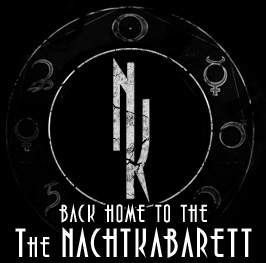
All content & writing by Brad Jaeger © The NACHTKABARETT
 Original Source of Image: Try, Try, Try (Front Cover)
Original Source of Image: Try, Try, Try (Front Cover)A two headed bird of one heart lies within a construction of snakes which form the symbol of mercury. The sun and moon lie under the heads of two serpents, as the king and queen hold the keys in their right hand. A white pelican in the lower left corner stabs its plumage with its beak, while a red phoenix in the lower right corner rises from a bed of flames.
The symbol of mercury is recurrent within alchemy, and is the sigil to the god of the same name. It may also evoke Hermes or Thoth; two other deities which are aspects of the 'thrice great', Hermes Trismegistus, who is so revered by the alchemists as being the founder of esoteric wisdom, language, the arts, and all natural philosophy and science.
The man and woman bear crowns which identify them as king and queen - typically a personification of the two halves of the androgyne: the masculine and feminine, red and white, Sol and Luna. Normally the king is coloured red and the queen white to strengthen this concept. The golden crown atop their heads is testament to their spiritual excellence and gnosis. In Kaballah, the Kether Sephiroth rests at the crown of the head. To adorn it with gold - symbolic of the sun and a pure radiating light - only serves to reinforce the magnitude of their inner light, or gnosis.
The two birds in the center are the focus of the image, and are undergoing a transformation to reduce them from two to one - like the infamous original androgyne. Signs of their duality are shown by the much smaller individual crowns each of them is wearing, stating that these were once two birds. However, we know the progression from two to one is occurring, as they already share only a single heart.
In the bottom left hand corner is a white pelican, symbolic of the feminine, whitening principle of Luna - an animal in the cloak of Albedo. Albedo is the stage in the alchemists' great work where the subject is purified by the removal of their impurities and readies itself for new life. As the pelican is usually white, it's no surprise to find it resting in the queen's corner. Conversely, it is of no surprise to see the red phoenix, symbolic of sol and Rubedo, in the corner of the (traditionally) red king.
The bird in the bottom right hand corner is a red phoenix. This reddened bird of Sol is the legendary bird of rebirth, which in death is reborn from the ash and flames of the previous phoenix.
The transition from Albedo to Rubedo, from ignorance to enlightenment, from pelican to phoenix, was perhaps best described in Alchemy and Mysticism:
The reddening or formation of the Red Stone was pictured through the symbol of the Pelican. The white pelican bird with its long bill reaching down over its breast, was in medieval times mistakenly observed piercing its breast with its bill and feeding its young on its own blood. What actually happens is that the bird regurgitates food it has caught earlier and its young feed on this ground up fish, bits of which fall onto the breast of the pelican and it appears as if its breast is bleeding. This myth of the sacrificial act of the Pelican in feeding its young on its own blood was more powerful than the prosaic reality and during medieval times the Pelican became a symbol for Christ's sacrifice of his blood. Alchemists also took this symbol aboard and readily incorporated it into their symbolic menagerie.
 The Self-sacrifice of the Peclian. From Alexander Roob's "Alchemy and Mysticism: The Hermetic Museum"
The Self-sacrifice of the Peclian. From Alexander Roob's "Alchemy and Mysticism: The Hermetic Museum"Of final importance, the source of the SP image is derived from the following:
 Illustration from Figuarum Aegyptiorum Secretarum, an 18th century work
Illustration from Figuarum Aegyptiorum Secretarum, an 18th century workThe image is described as follows:
Allegory of the marriage of the dual principles in the work: on the left the female, mercurial side with the pelican as a symbolic animal, feeding its young with its blood, and on the right, the male, sulphur side with the firebird, the Phoenix
 Original Source of Image: Try, Try, Try (Back Cover)
Original Source of Image: Try, Try, Try (Back Cover)There is a passage in Alchemy & Mysticism: The Hermetic Museum, by Alexander Roob, which reveals all we need to know about this image:
At the end of time, the prophets Elijah and Enoch, who are said to have been sent alive to Paradise, will appear and, with these signs, show the imminent destruction of corrupt Babylonian Christianity: the triple cross is the Trinity, now revealed in all things as their true signature. The sword and the rod announce that Babylon's force will turn against itself. The "grim wrath-fire of God" will soon engulf them both, and will begin the Golden Age of natural language "in which that which has been lost in the spirits of the letters will be rediscovered".
.jpg) Die letzte Posaune an alle Völker oder Prophezeiungen Jacob Böhmes, Berlin and Leipzig, 1779
Die letzte Posaune an alle Völker oder Prophezeiungen Jacob Böhmes, Berlin and Leipzig, 1779
